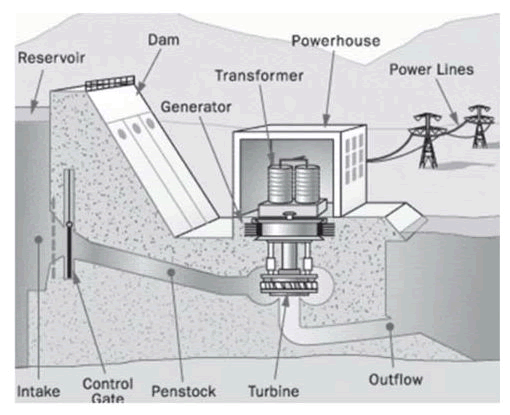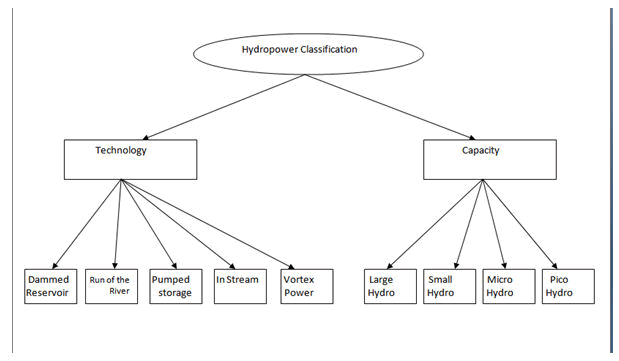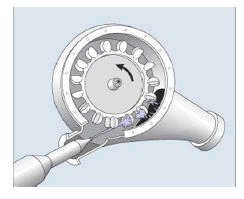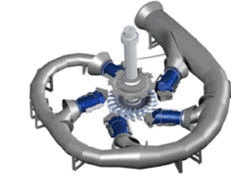Research Article, Vol: 11 Issue: 2
Electricity Production by Hydro Power Plant
Prasanna Mishra1*, Rishi Sikka1, Mamta Dhaiya2, Garima Goswami3
1Department of Computer Science and Engineering, Sanskriti University, Uttar Pradesh, India
2Department of Engineering, Shree Guru Gobind Singh Tricentary University, Haryana, India
3Department of Computer Science and Engineering, Teerthanker Mahaveer University, Uttar Pradesh, India
*Corresponding Author: Prasanna Mishra
Department of Computer Applications, PSG College of Technology, Coimbatore, India
E-mail: prasannamishra234@gmail.com
Received date: 29 January, 2021, Manuscript No. JNPGT-22-46165;
Editor assigned date: 31 January, 2021, PreQC No. JNPGT-22-46165(PQ);
Reviewed date: 14 February, 2022, QC No. JNPGT-22-46165;
Revised date: 21 February, 2022, Manuscript No. JNPGT-22-46165(R);
Published date: 24 February, 2022, DOI: 10.4172/2325-9809.1000257
Citation: Prasanna Mishra, Surya J, Bhama S (2021) Instant Wireless Message Notification. J Nucl Ene Sci Power Generat Technol 11:2.
Abstract
Energy production has many ways, also electricity is very important for daily life work, various ways introduced for the production of electricity like electricity production from water called hydro power plant, electricity produce from heat called thermal power plant, electricity produce from wind called wind energy power plant, electricity production from surface heat called geothermal energy. In this paper discussed the hydro power plant electricity production method and its advantages, drawbacks and its uses at various places. Hydro power plant is one of the most famous, efficient and useful methods for electricity production. Water is a good and efficient renewable energy source for electricity production. Production of electricity by using water has been coming for many decades and it proves itself a better and efficient method of electricity production. Hydro power plants are classified on the basis of power capacity and facility, the first one consist five technologies to make the power capacity fulfill, these five categories such as dammed reservoir, run of river, pumped storage, in stream technology and new technology gravitational vortex. The other category which is capacity is this category further classified on the basis of power limit such as large power, small power, mini power, micro and pico hydropower. Earlier villages are not that much developed due to which advance technology was unable to set up there but nowadays village and countries are in their growing stage so they using hydro power plant as their source of electricity production and this method more come in use due to its cheap and effective nature, this paper give a review of hydro power plant for producing electricity, also gives knowledge about hydropower system and the most suitable turbines which can be used in future.
Keywords: Hydropower; Dammed reservoir; Runs of river; In stream; Gravitational vortex; Turbines; Capacity; Cheap; Coal; Thermal; Reservoir
Introduction
Hydro power plants have become the power source and this method of electricity production has been praised by many countries. Many countries installed different types of and different capacities of hydro power plants according to the requirement of electricity. Hydro is a renewable energy resource and this is easily available everywhere due to which this method is cheap and more reliable. Based on the report of UNO there 7.6 billion approx people around the world have depended on hydroelectric power plants and this number is increasing day by day [1]. As per the previous data population have been increasing day by day and due to more population people of villages starts migrating into urban area called urbanization (over 55%), 70% of the total population lives in village but due to lack of jobs, facility and resources maximum youth migrate into town due to which population of town goes on increasing day by day, specially migration of those people from undeveloped region which need more energy and have high load requirement [2]. Every country is working on their economic sector more to increase the growth rate and other facilities of different generations. So every country is working on some development stages of industrialization until its inhabitants mature enough to use proper technology to harvest energy in a clean and renewable way by having the lowest possible impact on the local flora and fauna (Figure 1).

Figure 1: Hydro power plant.
Principle of hydro power plant
Hydro power plants used to produce electricity, hydroelectric power plants convert the potential energy of water due to its high location into electrical energy. Total storage capacity of water is high then power production is also high.
The water flowing in the river possesses two type of energy:
- The kinetic energy due to flow of water
- Potential energy due to the height of water
In hydroelectric power and potential energy of water is utilized to generate electricity. The formula for total power that can be generated from water in hydroelectric power plant due to its height is given:
P= q*h*g
Energy production has many ways, also electricity is very important for daily life work, various ways introduced for the production of electricity like electricity production from water called hydro power plant, electricity produce from heat called thermal power plant, electricity produce from wind called wind energy power plant, electricity production from surface heat called geothermal energy. In this paper discussed the hydro power plant electricity production method and its advantages, drawbacks and its uses at various places. Hydro power plants come in use in every country, also it is proven that hydro power plants are very good for urban as well as rural areas, when it comes for the growth and success of state or any country energy production for any state or country plays a very important role. Rather than the fixed collide of nuclear vs. nuclear free policy the RES is a natural form of energy harvesting with little or no pollution (Figure 2).

Figure 2: Hydropower categories (a) facilities (technologies) (b) power capacity.
The classification of hydropower plant facilities and its power capacity. Production of electricity by using water has been coming for many decades and it proves itself a better and efficient method of electricity production. Hydro power plants are classified on the basis of power capacity and facility, the first one consist five technologies to make the power capacity fulfill, these five categories such as dammed reservoir, run of river, pumped storage, in stream technology and new technology gravitational vortex. The other category which is capacity is this category further classified on the basis of power limit such as large power, small power, mini power, micro and pico hydropower.
Materials and Methods
What is hydro potential?
Hydro potential means how hydro is important for practical use such as production of electricity. Hydro potential numbers of power production in watt to be about 84,000 MW at 60% load factor (load factor is the effect of load either over or under voltage load on a hydro power plant). 6,780 MW in terms of installed capacity from Small, Mini, and Micro Hydel schemes have been assessed. Also, 56 sites for pumped storage schemes with an aggregate installed capacity of 94,000 MW have been identified. It is the most widely used form of renewable energy. India is blessed with an immense amount of hydroelectric potential and ranks 5th in terms of exploitable hydro potential in global scenario.
There have been many research papers and review papers have been published on the electricity production by utilising renewable energy resources such as solar, wind, geothermal, thermal and hydro, so among all the papers is a paper titled Hydro Power and Turbine Systems Reviews the different technologies used in the hydro power technology system [3]. Hydro power plants are classified on the basis of power capacity and facility, the first one consist five technologies to make the power capacity fulfill, these five categories such as dammed reservoir, run of river, pumped storage, in stream technology and new technology gravitational vortex. The other category which is capacity is this category further classified on the basis of power limit such as large power, small power, mini power, and micro and pico hydropower.
Earlier villages are not that much developed due to which advance technology was unable to set up there but nowadays village and countries are in their growing stage so they using hydro power plant as their source of electricity production and this method more come in use due to its cheap and effective nature, this paper give a review of hydro power plant for producing electricity, also gives knowledge about hydropower system and the most suitable turbines which can be used in future. In this paper discussed the power capacity and head classification, also data of Small-scale hydropower (MW) as defined by various countries shown, different technology classification also shown in this paper, discussed about Run of River (ROR) technology, discussed about the dammed reservoir technology, pumped storage technology, In-Stream Technology using Existing Facilities, VIVACE converter technology, gravitational vortex energy, Gravitational Vortex Plant, impulse turbines, turgo turbines, pelton turbines, cross flow turbines, reaction turbine, francis turbines, axial flow turbines propeller turbines, Pump as Turbine (PAT), Other reaction turbines.
In a research paper titled Hydro power plants, an overview of the current types and technology the types of hydro power plants [4]. Earlier villages are not that much developed due to which advance technology was unable to set up there but nowadays village and countries are in their growing stage so they using hydro power plant as their source of electricity production and this method more come in use due to its cheap and effective nature, this paper give a review of hydro power plant for producing electricity, also gives knowledge about hydropower system and the most suitable turbines which can be used in future. In this paper discussed the power capacity and head classification, also data of Small-scale hydropower (MW) as defined by various countries shown, different technology classification also shown in this paper, discussed about Run of River (ROR) technology, discussed about the dammed reservoir technology, pumped storage technology, In-Stream Technology using Existing Facilities, VIVACE converter technology, gravitational vortex energy, Gravitational Vortex Plant, impulse turbines, turgo turbines, pelton turbines, cross flow turbines, reaction turbine, francis turbines, axial flow turbines propeller turbines, Pump as Turbine (PAT), Other reaction turbines, Division of Hydro power plants according to configuration, Classification of the 2 largest hydro power plants in the world, types of turbines, hydro turbine manufacturing process and CFD software simulation, turbines division according to environment and applied medium, Turbines division according to the working principle, according to the energy conversion, according to the head, applications.
In a research paper an overview of hydro-electric power plant hydro potential, also discuss history of hydroelectricity, strengths of hydro power, weakness of hydro power, opportunities of hydro power, threats of hydro power, working principle of hydro- electric power plant, components of hydroelectric power plants, what is dam, trash rack, forebay, surge tank, water reservoir, water turbines, intake or control gates, the penstock, generators, spillway, power house. , this paper give a review of hydro power plant for producing electricity, also gives knowledge about hydropower system and the most suitable turbines which can be used in future. In this paper discussed the power capacity and head classification, also data of Small-scale hydropower (MW) as defined by various countries shown.
Results
The study of hydro power plants is designed in such a way that it divides it into two categories further classified on the basis of power limits such as large power, small power, mini power, micro and pico hydropower. Earlier villages are not that much developed due to which advance technology was unable to set up there but nowadays village and countries are in their growing stage so they using hydro power plant as their source of electricity production and this method more come in use due to its cheap and effective nature. Energy production has many ways, also electricity is very important for daily life work, various ways introduced for the production of electricity like electricity production from water called hydro power plant, electricity produce from heat called thermal power plant, electricity produce from wind called wind energy power plant, electricity production from surface heat called geothermal energy [5]. In this paper discussed the hydro power plant electricity production method and its advantages, drawbacks and its uses at various places. Hydro power plant is one of the most famous, efficient and useful methods for electricity production. water is a good and efficient renewable energy source for electricity production. Production of electricity by using water has been coming for many decades and it proves itself a better and efficient method of electricity production. Hydro power plants are classified on the basis of power capacity and facility, the first one consist five technologies to make the power capacity fulfill, these five categories such as dammed reservoir, run of river, pumped storage, in stream technology and new technology gravitational vortex. The other category which is capacity is this category further classified on the basis of power limit such as large power, small power, mini power, micro and pico hydropower (Table 1 and 2).
Table 1: Types of hydroelectric projects.
The different types of technology used in hydro power plants and which kind of services available with different technologies and what are their main energy sources.
Table 2: Installed capacities of countries leading in hydro power development.
Hydro Pelton wheel
In fig 1 shows a pelton turbine, which is used to pass the high speed water from nozzle which strikes the doubled cup buckets like structure connected to the wheel, this set up arranged at the periphery of wheel, that will produce force which rotates the wheel at high speed and gives good efficiency rate of 70 to 90 percentage.

Figure 3: Small hydro pelton wheel.
Turgo turbine
The turgo turbine, the turgo turbine used as high and medium head impulse turbine, turgo turbine can handle high water flow rate for energy production, also used to allow for proper operation in lower head ranges it is able to perform this because it can allow operation in lower range of water, because it can give efficient result by using more water with less head.

Figure 4: Turgo turbine.
Multi jet Pelton turbine
A pelton turbine, which is used to pass the high speed water from nozzle which strikes the doubled cup buckets like structure connected to the wheel, this set up arranged at the periphery of wheel, that will produce force which rotates the wheel at high speed and gives good efficiency rate of 70 to 90 percentage.

Figure 5: Multi jet Pelton turbine.
Discussion
In this paper discussed the hydro power plant electricity production method and its advantages, drawbacks and its uses at various places [7]. Hydro power plants come in use in every country, also it is proven that hydro power plants are very good for urban as well as rural areas, when it comes for the growth and success of state or any country energy production for any state or country plays a very important role. Rather than the fixed collide of nuclear vs. nuclear free policy the RE is a natural form of energy harvesting with little or no pollution. This paper shows different kinds of hydro power plants used by different countries such as Brazil ≤ 30, Cand <50, China ≤ 50, EU Linking Directive ≤ 20, India ≤ 25, Norway ≤ 10, Sweden ≤ 1.5, USA 5-100. This paper also shows different kind of hydroelectric project dammed Reservoir Power and Energy Changes of habitat and social impacts due to reservoir, Modification of river flows, Run Of River Base load with limited flexibility, Limited flooding, River flows unchanged, Pumped Storage Power only, Net consumer of energy, Impacts related to, upper storage pool, In Stream Energy and power Reduction of flow downstream of diversion. When it comes to hydro energy it is a very famous technology which is very close to the imagination of a large spectrum of the population [8]. Hydro power plant is a Renewable Energy Resource (RES) and availability of its main energy source which is water is commonly available. Hydro power system is an energy storage method and also it can transform energy from one part to another, in urban areas their main motive is sustainable development [9]. This paper described the technology behind hydro power plant, turbines used in hydro renewable energy fields. It indicates that hydro is a major sector of the electric generation power plant which has proved itself as a great energy resource worldwide, in this paper also discussed the benefits of hydro power plants on the environment and economy of that place.
Conclusion
Energy production has many ways, also electricity is very important for daily life work, various ways introduced for the production of electricity like electricity production from water called hydro power plant, electricity produce from heat called thermal power plant, electricity produce from wind called wind energy power plant, electricity production from surface heat called geothermal energy. In this paper discussed the hydro power plant electricity production method and its advantages, drawbacks and its uses at various places. Hydro power plants come in use in every country, also it is proven that hydro power plants are very good for urban as well as rural areas, when it comes for the growth and success of state or any country energy production for any state or country plays a very important role. Rather than the fixed collide of nuclear vs. nuclear free policy the RE is a natural form of energy harvesting with little or no pollution. When it comes to hydro energy it is a very famous technology which is very close to the imagination of a large spectrum of the population. Hydro power plant is a Renewable Energy Resource (RES) and availability of its main energy source which is water is commonly available. Hydro power system is an energy storage method and also it can transform energy from one part to another, in urban areas their main motive is sustainable development. This paper described the technology behind hydro power plant, turbines used in hydro renewable energy fields. It indicates that hydro is a major sector of the electric generation power plant which has proved itself as a great energy resource worldwide, in this paper also discussed the benefits of hydro power plants on the environment and economy of that place. This paper also shows various types of hydropower turbines system and their components and its working. From the above study, it can be provided a guideline to reach about the suitable hydropower system and turbine which can be used in the different hydropower projects.
References
- Anon (1984) Hydro power. Civ Eng New York.
- BA Nasir (2014) Design considerations of micro-hydro-electric power plant. Energy Procedia 50: 19-29.
- U Dorji, R Ghomashchi (2014) Hydro turbine failure mechanisms: An overview. Eng Failure Analy.
- AH Elbatran, MW Abdel-Hamed, OB Yaakob, YM Ahmed, M Arif Ismail (2015) Hydro power and turbine systems reviews. J Teknol 74: 83-90.
- H Sharma, J Singh (2013) Run off river plantâ?¯: Status and prospects. Int J Innov Technol Explor Eng 3.
- S Sangal, A Garg, D Kumar (2013) Review of optimal selection of turbines for hydroelectric projects. Rev Optim Sel Turbines Hydroelectr Proj.
- VK Singh, SK Singal (2017) Operation of hydro power plants-a review. Renewable Sustainable Energy Rev.
- R Raja Singh, T Raj Chelliah, P Agarwal (2014) Power electronics in hydro electric energy systems - A review. Renewable Sustainable Energy Rev 69, 610-619.
- BA Nasir (2014) Design of micro-hydro-electric power station. Int J Eng Adv Technol 2.
 Spanish
Spanish  Chinese
Chinese  Russian
Russian  German
German  French
French  Japanese
Japanese  Portuguese
Portuguese  Hindi
Hindi 

